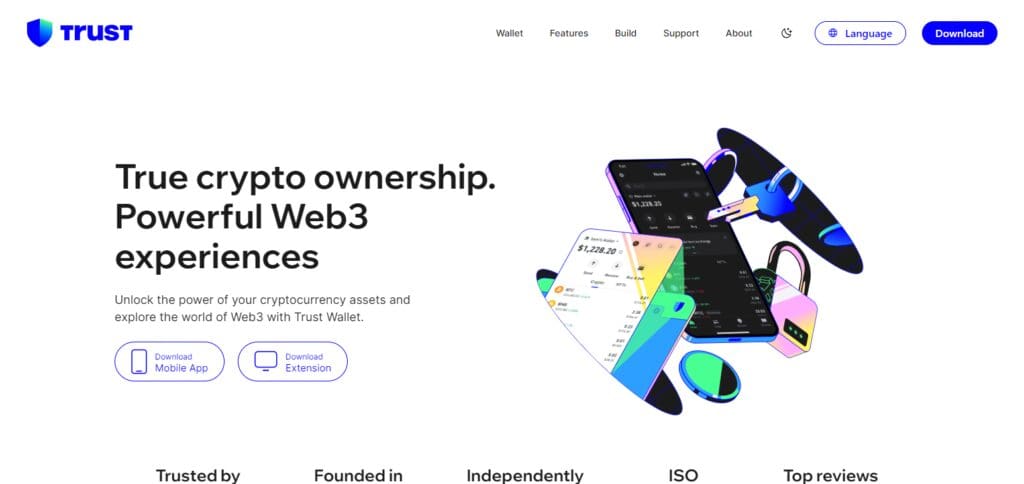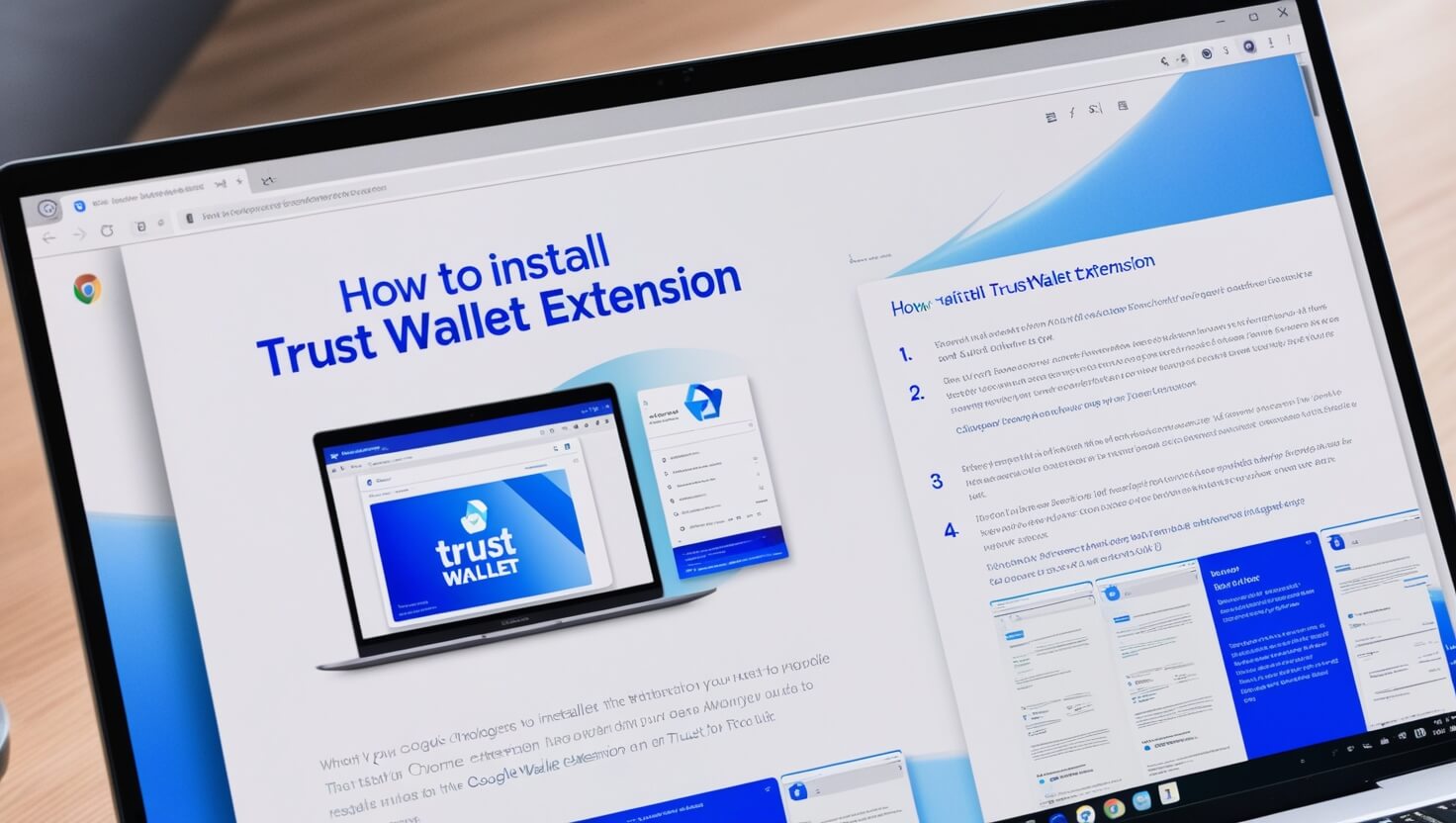In this article, I will analyze the Trust Wallet Extension which is an all-in-one and easy to use tool that helps in managing cryptocurrency.
The Trust Wallet Extension integrates with the browser making it easy to interact with dApps and it also includes solid security features to protect users’ funds.
This extension adds speed and usability that balance the needs of both advanced traders and crypto fans, making it simple to use the decentralized internet.
What is Trust Wallet?
Trust Wallet is a cryptocurrency wallet that is both decentralized and secure enabling its users to send, receive, or store a variety of digital currencies such as Bitcoin, Ethereum, and numerous altcoins.

Because Trust Wallet is non-custodial, its user has total control over private keys and funds. Trust Wallet also allows the use of DApps and Web3 giving users the ability to engage with various services like DeFi platforms, NFT marketplaces, and many more.
In 2018, Trust Wallet was bought by Binance. Trust Wallet is reputable for it being user- friendly, having multi-chain support and strong security features which makes it popular among both novice and advanced cryptocurrency users.
How to Install Trust Wallet Extension?

Visit the Trust Wallet Website
Start by accessing the Trust Wallet’s official site and go to the browser extension section.
Choose Your Browser

Trust Wallet extension can be installed on Chrome, Brave, Opera and Edge. Choose the link that corresponds to your browser.
Add the Trust Wallet Extension
Select the Add to Chrome button. This will take you to your browser’s extension page.
Install the Extension
Proceed with the instructions to install the extension. If you are using Chrome, you can download it from here .
Set Up Your Wallet
After installation, you can launch the extension and create a wallet using the secret recovery phrase to import an existing wallet.
Secure Your Wallet
Always remember to set a secure password and keep your recovery phrase safe.
How to Use Trust Wallet Extension?
Install the Extension: If you have not done this yet, make sure you get the Trust Wallet extension from the Trust Wallet website.

Create or Import a Wallet: Within the extension, click on the ‘Create New Wallet’ while selecting your secret recovery phrase, or choose ‘Import Wallet’ if you wish to use an existing wallet.
Add Custom Tokens: By pressing on the “Add Token” icon, you can input the token’s contract address to add custom tokens.
Send and Receive Crypto: Press the “Send” button to forward cryptocurrency. Give the wallet address and amount, and it will be sent. To have crypto sent to your wallet, click on the “Receive” button and give the person your wallet address.
Interact with dApps: You are able to connect the Trust Wallet extension with dApps like Uniswap and PancakeSwap. All you need to do is go to dApp’s website and connect Trust Wallet.
Manage Wallets and Settings: Manage your wallets, networks and security in the settings menu.
Security Tips for Trust Wallet Extension
Allow me to highlight some handy security recommendations when using the Trust Wallet extension:
Use Biometric Authentication: Ensure to secure mobile devices with facial or fingerprint recognition for extra layers of protection.
Keep Your Software Up to Date: Update your Trust Wallet extension on a regular basis so as to capture the latest features.
Set Strong Passwords: Set a complex and unique wallet password so as to greatly limit unauthorized entries.
Be Careful About Phishing Attempts: Always ascertain the legitimacy of links and websites before adding sensitive information.
Secure Secret Recovery Phrase: Always secure back-up to your Secret Recovery Phrase at a regularly checked location.
Enable Two-Factor Authentication: Whenever appropriate, turn on 2FA to enhance the security of your wallet.
Watch Out for Transactions: Look out for unauthorized transactions as you regularly check your history.
Do Not Use Public Wi-Fi: Accessing your wallet should only be done under a secure and private internet access.
Pros & Cons Of Trust Wallet Extension
Pros
User-Friendly Interface: Trust Wallet boasts a simple client-friendly interface which is ideal for both amateurs and advanced users.
Supports Multiple Cryptocurrencies: It supports a plethora of cryptocurrencies and NFTs enabling the users to store multiple digital assets.
Non-Custodial Wallet: As a non-custodial wallet, Trust Wallet empowers users with complete control over private keys and funds.
Built-In Web3 Browser: The extension includes a browser that facilitates dApps interactions with ease.
Staking and Swapping: Trust Wallet customers can easily stake their assets and directly swap cryptocurrencies inbuilt within the wallet.
Cons
No Two-Factor Authentication (2FA): As it stands, Trust Wallet does not offer 2FA which may be a drawback for some users.
Limited Customer Support: Trust Wallet’s limited customer service options might be a drawback for customers dipping their toes into the water.
No Cold Storage: Trust Wallet does not offer cold storage which makes it less secure than hardware wallets.
Questionable Legitimacy Of Some Supported Assets: Some assets are supported but may not be the most legit, posing risks in the long term.
Conclusion
Finally, the last step on how to install the Trust Wallet extension is simple. It just requires a few elementary actions: navigating to the Trust Wallet website, selecting the desired browser, downloading the extension, and creating the wallet.
Completing these steps makes it simple for users to manage and access their cryptocurrencies. Always remember to keep your recovery phrase secure and adhere to robust security protocols to safeguard your assets. Best regards in your explorations! Should you wish to inquire further, don’t hesitate to reach out.










